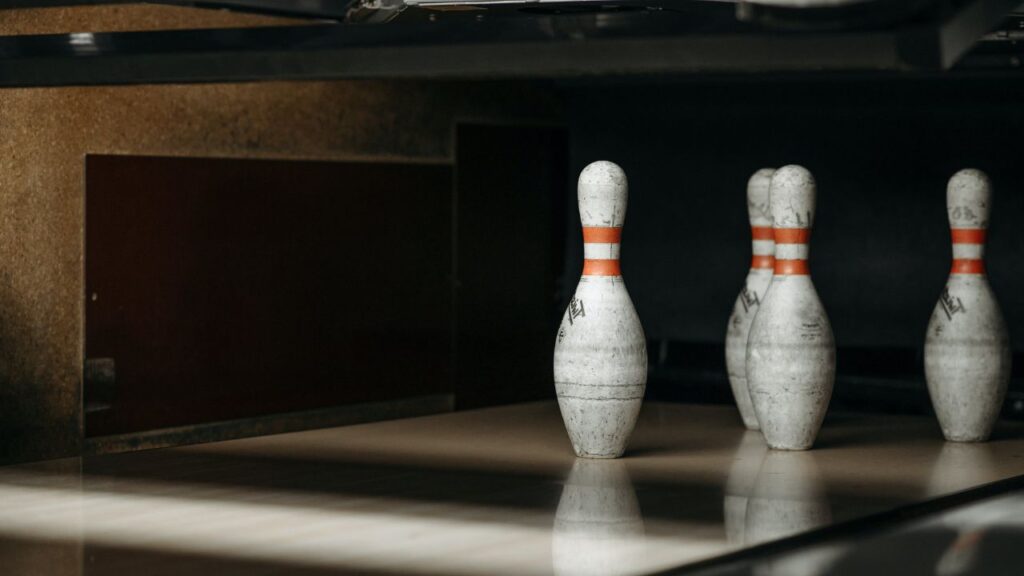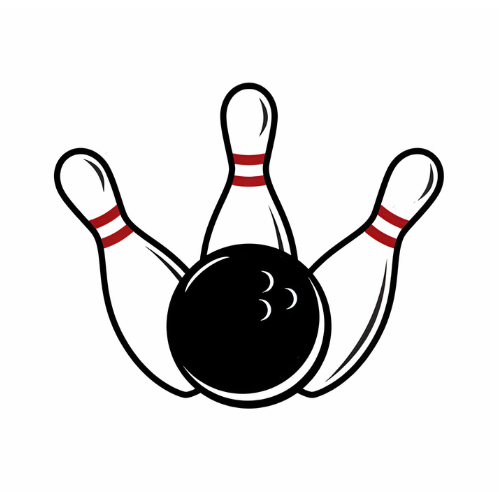Open-frame bowling refers to a frame in which no pins are knocked down with two balls, while a closed frame is when a player either strikes or spares. Bowling frames define a player’s score in a single round, either boosting their total with a closed frame or leaving potential points on the lane with an open frame.
An open frame in bowling marks a missed opportunity as it spells a lack of strikes or spares; it can hinder a player’s path to achieving a high score. On the flip side, a closed frame, achieved through knocking down all pins in either one or two tries (a strike or spare, respectively), maximizes a player’s scoring potential for that particular frame.
These concepts are crucial for both amateur and professional bowlers aiming to refine their game strategy and rack up higher overall scores. Understanding the difference and the strategies to avoid open frames while aiming for closed ones can dramatically impact the final score in a game of bowling.

Introduction To Bowling Dynamics
Introduction to Bowling Dynamics unlocks the mysteries of a classic alley showdown. It’s not just rolling a ball; it’s a strategic play of power, spin, and timing. Whether you’re a casual player or aiming for strikes like a pro, understanding the open frame versus closed frame can level up your game. Let’s dive into the core elements that make bowling an exciting sport.
Understanding The Bowling Lane
The bowling lane is your battlefield. It’s a flat surface, 60 feet long, with subtle oil patterns. These unseen patterns affect the ball’s trajectory. Knowing how to read the lane can be the difference between a strike or a gutter ball.
The Role Of Pins In Scoring
Scoring in bowling is about knocking down pins the central objective. A closed frame, like a strike or spare, means you’ve knocked them all down in one or two tries. Conversely, an open frame signifies leftover pins, offering lower scores.
Basics Of Bowling Techniques And Terminologies
Bowling has its unique language and essentials. A strike clears the deck in one roll, and a spare cleans up in two. Your approach, grip, and release all shape your shot’s destiny. Mastering these techniques can turn an open frame into a satisfying closed one.
Open Frames In Bowling Explained
Understanding the difference between open and closed frames in bowling is crucial for players aiming to boost their scores. An open frame denotes a turn where pins remain standing after two balls, contrasting sharply with a closed frame where all pins are knocked down, often resulting in higher points.
Bowling scores can puzzle beginners and professionals alike. Among the concepts to grasp, understanding open frames is crucial. Whether playing for fun or competition, knowing about open frames can shape your bowling strategy.
Defining Open Frames
An open frame in bowling happens when a player fails to knock down all ten pins across two tries in a single frame. Unlike strikes or spares, open frames leave pins standing after a player’s second ball, resulting in missed scoring opportunities.
Common Causes For An Open Frame
- Poor ball release
- Incorrect aim or target
- Unsuitable ball weight
- Inconsistent bowling technique
- Lane conditions
Each cause relates to the bowler’s control and interaction with the lane. Addressing these elements can reduce open frames occurrence.
The Impact Of Open Frames On Overall Score
Open frames significantly affect the overall score in bowling. Since no extra points are scored beyond the pins knocked down, an open frame leads to a lower total. Consequently, this can widen the gap between players or teams in a competitive setting.
| Frame | 1st Roll | 2nd Roll | Impact |
|---|---|---|---|
| 1 | 7 | 2 | Open frames contribute to a lower cumulative score |
| 2 | 8 | 1 | |
| 3 | 4 | 4 |
Strategies To Avoid Open Frames
- Practice consistently to improve technique.
- Learn to read and adjust to lane conditions.
- Choose the right ball weight.
- Focus on spare shooting skills.
- Develop a pre-shot routine for better focus.
Employing these strategies can lead to more spares and strikes, preventing open frames and boosting scores.
Closed Frames In Bowling: Aiming For Strikes And Spares
In the game of bowling, mastering closed frames can drastically change the scoreboard. Whether you’re striving for a strike or picking up a spare, efficiently closing the frame is crucial. Let’s dive into the secrets behind scoring high with every roll.
Differentiating Between Strikes And Spares
A strike means knocking down all ten pins with the first ball. Not only does it look impressive, it also adds bonus points. A spare occurs when all pins fall after the second ball, still boosting the score with extra points from the next ball rolled.
- Strike: All ten pins down with first roll.
- Spare: Clearing remaining pins with second roll.
Technical Aspects Of Achieving A Closed Frame
To convert open frames into closed ones, accuracy and technique come into play. The right approach, timing, and ball release are essential to maintain control and hit the target.
| Aspect | Importance |
|---|---|
| Approach | Builds momentum and direction |
| Timing | Synchronizes movements for impact |
| Release | Determines ball trajectory |
How Closed Frames Boost Your Game Score
Closed frames are the key to maximizing points in bowling. Strikes offer a bonus of the next two balls thrown, while spares add the next ball’s pins to the total. This system makes consecutive closed frames especially powerful.
- Strike: Next two balls’ pins added to score.
- Spare: Next ball’s pins added to score.
Tips And Techniques For Consistent Strikes
Aiming for strikes means focusing on the pocket the space between the 1-3 pins for right-handers, and 1-2 for left-handers. Consistent practice with focus on form can lead to more strikes and higher scores.
- Align your feet and shoulders toward the pocket.
- Keep your arm swing smooth and consistent.
- Practice release drills to refine your technique.
Comparative Analysis Of Open And Closed Frames
Analyzing the outcomes in bowling hinges on understanding the dynamics of open and closed frames. Delving deep, we reveal how each frame type alters player psychology, affects scores, and demands strategic shifts. Professional insights further illuminate the path to elevating one’s game.
Psychological Effects On Players
Open frames, where pins remain standing after two attempts, often cause frustration. Feelings of disappointment can influence subsequent frames. On the contrary, closed frames either strikes or spares boost confidence, generating a positive feedback loop.
Statistical Impact On Game Outcomes
The distinction between open and closed frames is evident in game statistics. A table showcases the potential score fluctuation:
| Frame Type | Average Score Impact |
|---|---|
| Open Frame | -10 Points |
| Closed Frame (Spare) | +10 Points |
| Closed Frame (Strike) | +30 Points |
Closed frames, especially strikes, significantly contribute to higher final scores, influencing not just individual but team standings.
Adjustments In Strategies And Techniques
The transition from open to closed frames can involve technique fine-tuning. Key adjustments include:
- Ball Grip: Firmer for control
- Approach: Adjusted for consistency
- Release: Tweaked for accuracy
These tweaks aid players in converting open frames into more favorable closed frames.
Learning From Professional Bowlers
Observing professionals, we notice patterns:
- Mentally resetting after an open frame
- Adapting to lane conditions for closed frames
- Staying composed under pressure
Adopting these practices from seasoned bowlers can guide amateurs toward better performance, emphasizing the importance of resilience and adaptability in bowling.
Practical Advice For Amateur Bowlers
Stepping into the bowling alley can be a thrilling experience. To excel in the sport, amateur bowlers need essential tips. With the right approach, they can better understand the dynamics of open frame and closed frame in bowling, leading to improved play and higher scores. Let’s dive into these practical pearls of wisdom, aimed at boosting performance for beginners and enthusiasts alike.
Improving Bowling Accuracy And Consistency
Success in bowling hinges on precision and regularity. Try these tips:
- Focus on your stance. Keep it steady.
- Align your shoulders with pins. This enhances aim.
- Choose a mark on the lane. Let it guide your throw.
- Release the ball smoothly. Practice the same motion each time.
- Review each play. Learn from mistakes.
Equipment Selection For Better Performance
Right gear can be a game-changer. Consider these aspects:
| Equipment | Why It Matters |
|---|---|
| Bowling Ball | Select a ball that fits your hand comfortably. |
| Shoes | Wear shoes that prevent slipping and facilitate motion. |
| Accessories | Use wrist supports for greater control. |
The Importance Of Practice And Coaching
Mastering bowling demands regular practice and coaching. Embrace these strategies:
- Attend weekly sessions. Build muscle memory.
- Work with a coach. Gain insightful feedback.
- Watch professionals. Observe their technique.
Setting Realistic Goals And Tracking Progress
| Goal Setting | Progress Tracking |
|---|---|
| Define clear objectives. Aim at incremental achievements. | Keep a log. Celebrate every milestone. |
| Adjust goals as needed. Stay flexible. | Use apps or journals. Monitor your development. |
FAQ
What Is Considered An Open Frame In Bowling?
An open frame in bowling is when a player fails to knock down all ten pins within two attempts in a single frame.
What Is A Closed Game In Bowling?
A closed game in bowling refers to a perfect game where a player scores 300 points by rolling strikes in all ten frames.
What Is The Meaning Of Open In Bowling?
In cricket, “opening the bowling” refers to the act of bowling the first over in an innings. The chosen bowler is typically a specialist who excels in taking advantage of the fresh pitch and ball conditions.
What Does Frames In Bowling Mean?
Frames in bowling refer to the ten divisions of a game during which a bowler has the opportunity to knock down pins. Each frame allows for two chances to roll, except the tenth, which can offer a third roll for bonus points.
Conclusion
Understanding the difference between open and closed frames is crucial for bowling enthusiasts aiming to improve their game. By mastering both frame types, players enhance their strategic approach to each roll. Embrace these concepts, refine your skills, and watch your scores soar.
Remember, every frame is an opportunity for growth in the alley!

